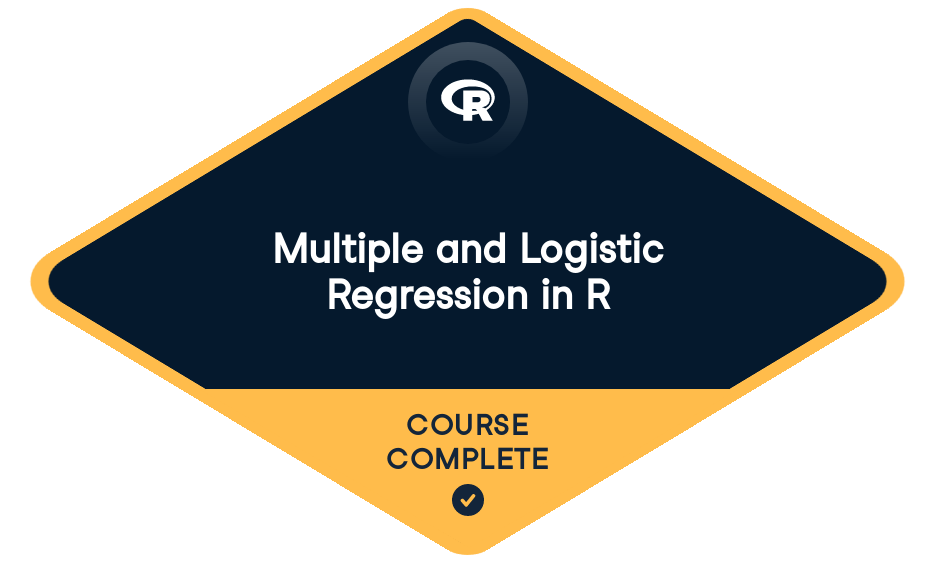Md. Saif Kabir Asif has completed
Multiple and Logistic Regression in R
Start course For Free4 hours
4,250 XP

Loved by learners at thousands of companies
Course Description
In this course you'll take your skills with simple linear regression to the next level. By learning multiple and logistic regression techniques you will gain the skills to model and predict both numeric and categorical outcomes using multiple input variables. You'll also learn how to fit, visualize, and interpret these models. Then you'll apply your skills to learn about Italian restaurants in New York City!
For Business
Training 2 or more people?
Get your team access to the full DataCamp library, with centralized reporting, assignments, projects and more- 1
Parallel Slopes
FreeIn this chapter you'll learn about the class of linear models called "parallel slopes models." These include one numeric and one categorical explanatory variable.
What if you have two groups?50 xpFitting a parallel slopes model100 xpReasoning about two intercepts50 xpVisualizing parallel slopes models50 xpUsing geom_line() and augment()100 xpInterpreting parallel slopes coefficients50 xpIntercept interpretation50 xpCommon slope interpretation50 xpThree ways to describe a model50 xpSyntax from math100 xpSyntax from plot100 xp - 2
Evaluating and extending parallel slopes model
This chapter covers model evaluation. By looking at different properties of the model, including the adjusted R-squared, you'll learn to compare models so that you can select the best one. You'll also learn about interaction terms in linear models.
Model fit, residuals, and prediction50 xpR-squared vs. adjusted R-squared100 xpPrediction100 xpUnderstanding interaction50 xpThought experiments50 xpFitting a model with interaction100 xpVisualizing interaction models100 xpSimpson's Paradox50 xpConsequences of Simpson's paradox50 xpSimpson's paradox in action100 xp - 3
Multiple Regression
This chapter will show you how to add two, three, and even more numeric explanatory variables to a linear model.
Adding a numerical explanatory variable50 xpFitting a MLR model100 xpTiling the plane100 xpModels in 3D100 xpConditional interpretation of coefficients50 xpCoefficient magnitude50 xpPracticing interpretation50 xpAdding a third (categorical) variable50 xpVisualizing parallel planes100 xpParallel plane interpretation50 xpHigher dimensions50 xpInterpretation of coefficient in a big model50 xp - 4
Logistic Regression
In this chapter you'll learn about using logistic regression, a generalized linear model (GLM), to predict a binary outcome and classify observations.
What is logistic regression?50 xpFitting a line to a binary response100 xpFitting a line to a binary response (2)100 xpFitting a model100 xpVisualizing logistic regression50 xpUsing geom_smooth()100 xpUsing bins100 xpThree scales approach to interpretation50 xpOdds scale100 xpLog-odds scale100 xpInterpretation of logistic regression50 xpUsing a logistic model50 xpMaking probabilistic predictions100 xpMaking binary predictions100 xp - 5
Case Study: Italian restaurants in NYC
Explore the relationship between price and the quality of food, service, and decor for Italian restaurants in NYC.
Italian restaurants in NYC50 xpExploratory data analysis50 xpSLR models100 xpIncorporating another variable50 xpParallel lines with location50 xpA plane in 3D100 xpHigher dimensions50 xpParallel planes with location100 xpInterpretation of location coefficient50 xpImpact of location100 xpFull model50 xpWrap-up50 xp
For Business
Training 2 or more people?
Get your team access to the full DataCamp library, with centralized reporting, assignments, projects and moreCollaborators

Prerequisites
Correlation and Regression in RBen Baumer
See MoreAssistant Professor at Smith College
Ben is an Assistant Professor in the Statistical & Data Sciences Program at Smith College. He completed his Ph.D. in Mathematics at the Graduate Center of the City University of New York in 2012. He is an Accredited Professional Statistician™ by the American Statistical Association and was previously the Statistical Analyst for the Baseball Operations department of the New York Mets.
Join over 13 million learners and start Multiple and Logistic Regression in R today!
Create Your Free Account
or
By continuing, you accept our Terms of Use, our Privacy Policy and that your data is stored in the USA.